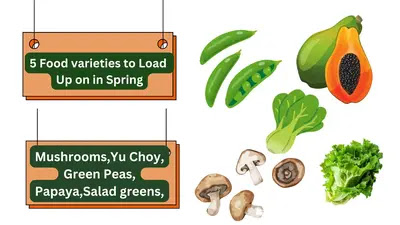5 Food Varieties to Load Up on This Spring 🌱🍓
5 Food Varieties to Load Up on in Spring, As per a Dietitian
At the point when the schedule moves into Spring, you can nearly feel the moving of seasons. The dim and cold days are supplanted by somewhat longer,, sunnier, hotter ones. The break in weather conditions gives life to the produce we've come to connect with spring. Gone are the durable leafy foods of the colder time of year, supplanted by splendid, delicate shoots, organic products, leaves, and stems of spring produce. There's such a great amount to appreciate, however, these are the best 5 food varieties you ought to load up on this Walk.
1. Papaya
If Walk makes them feel like you want a portion of daylight in plant structure, then, at that point, get a papaya whenever you're at the store. Papayas are only accessible for a couple of months a year, so get them while they're in season, suggests Diana Plateau, RDN, CDCES, organizer behind En La Plateau Nourishment. Papayas are plentiful in nutrients A, C, potassium, and fiber, and they have a scrumptious and extraordinary flavor that goes perfectly in smoothies, oats, and yogurt or can be delighted in all alone, says Plateau.
Papayas can be eaten green or ready. For dishes like green papaya salad, you'll need to pick a firm, green natural product, says Plateau. On the off chance that you're searching for a sweet, ready papaya, it will be generally yellow with perhaps a couple of green spots on it and a piece delicate to the touch — not soft, a sign that it's overripe.
2. Green Peas (new)
If you've at any point had new green peas, you know they're a heavenly spring food that can't be missed! The little peas are sweet and fresh, giving the ideal charmingly lush pop to everything, from servings of mixed greens to pan-sears. New peas are a reasonable plant protein, says Krystal Dunham, M.S., RDN, proprietor of The Mother Street Dietitian. Additionally, they supply around 9 grams of filling, and assimilation cordial fiber per 1 cup cooked, as indicated by the USDA.
Dunham suggests blitzing peas in a food processor alongside garlic, lemon juice, Parmesan cheddar, olive oil, salt, and pepper to use as a spread on sourdough toast. Or then again spring forward with Pea Soup or Quinoa with Peas and Lemon.
3. Yu Choy
Yu choy or choy aggregate is otherwise called Chinese blooming cabbage. A kind of Chinese cabbage develops as delicate green-leafed follows and is a piece of the cruciferous group of veggies. This makes you choy wealthy in cell reinforcements and mixtures with potential mitigating and against malignant growth properties, says Cindy Chou, RDN, gourmet expert and sustenance master representing considerable authority in East Asian food and pioneer behind The Sound of Cooking.
Chou loves to appreciate yu choy at the top season — which is spring for most pieces of the U.S. — when the stems are better than expected. Setting it up is additionally straightforward, says Chou, adding that yu choy leaves are smooth and simple to wash. Cut bundles to add to sautés, or slash and throw into soups during the most recent five minutes of stewing.
4. Mushrooms
Mushrooms pack serious flavor, particularly in vegan dishes that can frequently need appetizing quality. Whether new, frozen, canned, or dried, mushrooms add a decent extravagance to dishes thanks to the regular glutamate they contain, says gourmet specialist and enlisted dietitian Tessa Nguyen, RD, the pioneer behind Taste Sustenance Counseling. Glutamate, additionally called glutamic corrosive, is an amino corrosive in mushrooms that adds to their particular umami flavor. "With such countless various assortments, mushrooms offer different surfaces and flavor profiles, which makes them enjoyable to attempt in various recipes," she says. Have a go at cooking or sautéing mushrooms, as well as blending grows into burgers like in these Barbecued Meat Mushroom Burgers with Speedy Pickles.
5. Salad greens
The generous leaves of kale and collards are heavenly, however, spring carries with it the delicate pleasantness of spinach and watercress and the brilliant harshness of arugula and endive. They're additionally nutritious, says plant-based master Vandana Sheth, RDN, CDCES. "These mixed greens are low in calories, yet loaded with supplements, including nutrients A, C, E, and K, and minerals like iron and calcium," she says. Additionally, green leafies supply cancer prevention agents that counter cell-harming oxidative pressure. Sheth suggests getting a charge out of mixed greens crude in plates of mixed greens, smoothies, or cooked as a fast side dish. A few thoughts for champion sides? Attempt Watercress with Rice Wine-Clam Sauce, Creamed Spinach or Spice, and Arugula Salad with Balsamic Vinaigrette.
Primary concern
The long stretch of Spring is an incredible opportunity to load up on spring produce. Fill your truck with papaya, new green peas, yu choy, mushrooms, and salad greens, and partake in these food varieties at their pinnacle of newness. Each is loaded with different supplements to assist with energizing the more extended, hotter days.
1. What are some seasonal fruits that are beneficial to include in a spring diet?
2. Can you recommend a few leafy green vegetables that are abundant and nutritious during the spring season?
3. Are there any particular seafood options that are optimal to consume in the spring months?
4. Which grains or legumes are ideal choices to incorporate into meals during the springtime?
5. Could you suggest some dairy or non-dairy products that align with a spring diet and provide essential nutrients?









.png)



0 Comments
please do not enter spam link in the comment box.